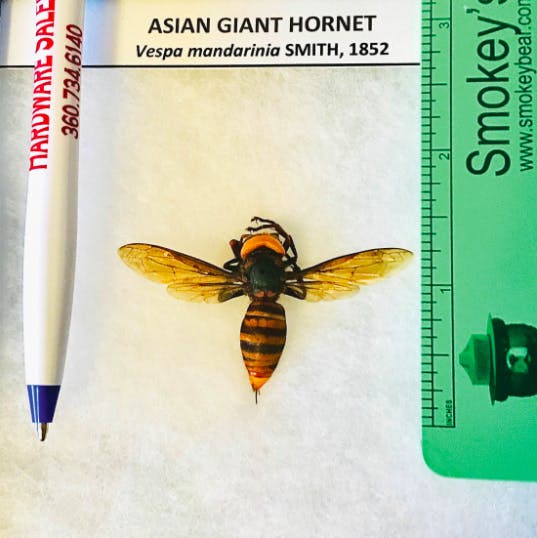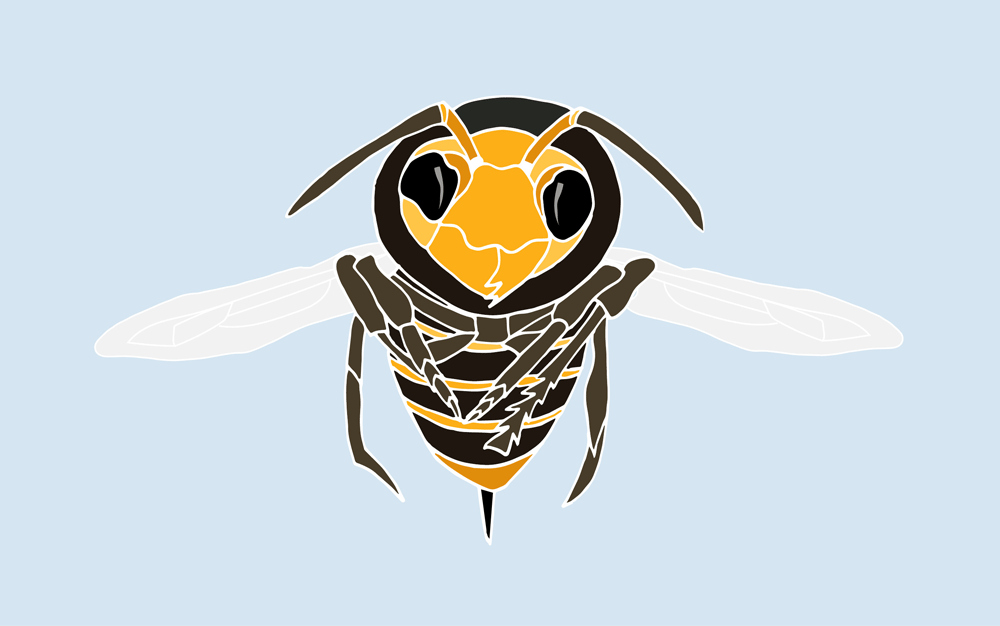
By Ian Ferguson
Late last year, sightings of an invasive Asian giant hornet, the largest hornet species in the world, were confirmed in Whatcom County. The largest of these hornets measures up to two-inches long and their sting is said to be excruciating. They have been referred as “the most intimidating insect on earth.”
The Washington Department of Agriculture confirmed four reports of the hornet in December 2019, all of which were found in Whatcom County. According to Timothy Lawrence, director of the Washington State University Island County Extension, there have been no confirmed sightings in 2020.
According to a Washington State University fact sheet, the consequences for European honeybee colonies — the hornet’s primary food source and the common beekeeper’s bee — may be severe. An impact to honeybee colonies could have serious implications for Whatcom County’s agriculture industries.
Chris Benedict, an agriculture agent with the Washington State University Extension in Bellingham, said that farmers and gardeners in Whatcom County rely on partnerships with beekeepers and their honeybee colonies to pollinate crops.
“Agriculture is a major industry in Whatcom County,” Lawrence said. “Anything that’s going to cause problems for those two industries is going to take a hit on the economy.”
Lawrence said migratory beekeepers travel from state to state pollinating various crops. They begin with almonds in California, then move north pollinating cherry, apple and pear crops and eventually reach the raspberry and blueberries in Whatcom County. Lawrence said there is potential for beekeepers to avoid areas with established hornet populations.
The WSU Extension office reported that the Whatcom County agriculture industry has a market value of over $300 million, ranking first among the seven Western Washington counties.
“We rely on imported honeybees for the vast majority of our horticultural crops,” Benedict said. “So it would be a big issue.”
According to the fact sheet, the hornets attack bee hives in three stages: hunting, slaughter and occupation. By the end of the final stage, colonies of 30,000 to 50,000 honeybees will be almost entirely decimated by just 15 to 30 Asian giant hornets.
“We are very nervous about what might happen this fall,” said Ruth Danielson, a member of the Mt. Baker Beekeepers Association. Fall is when the hunters begin scouting for food sources, she said, they’ll mark hives with a chemical pheromone which recruits other hunters for the slaughter, and occupation phases.
She said those final phases are what creeps her out the most.
“Say they mark one of my hives and they take over that hive, they would be very aggressive towards who tried to stop them,” she said. The average beekeeper suit is not protective against the hornet’s quarter inch stinger, Danielson said.
While not usually aggressive toward humans, Lawrence said they are known to attack humans and animals who encroach on their nest or food source. Their stinger, about a quarter of an inch long, packs a powerful and painful sting, and they can sting multiple times, unlike honeybees.
In attempts to avoid this, Danielson said she organized “a little army” of beekeepers to set up traps that attract queens. She said they now have 61 traps set up ranging from just south of the Canadian border to south of Lake Samish.
“It’s scary and sad,” she said. “Our bees are like if you have a little goat, to me they’re a little farm animal.”
Lawrence said there are still many unknowns when it comes to the impacts there may be. In Asian regions, beekeepers are non-migratory and keep much smaller colonies of honeybees. There is no precedent for the establishment of the Asian giant hornet in regions with migratory beekeepers, who keep hundreds to thousands of colonies on a single lot, Lawrence said.
The extent of these consequences relies on how well established the hornets have become. According to Lawrence, the verdict here is still out. While there have been no sightings this year, he said, we’re still not in the clear.
“I would imagine that we are not going to be out of the woods for sure unless we have two or three years of no finds,” he said.
If the hornets are established, Lawrence said the species will likely acclimate well to the region, especially on the west side of the Cascades, where the climate and geography is similar to lower mountainous areas of East Asia.
The queens will be just coming out of hibernation now, flying solo looking for sources of carbohydrates like tree sap, Lawrence said. Sightings likely won’t occur until fall after the queens have established hives, and “worker” hornets are out foraging and hunting, he said.
Benedict said that right now it is important that the public is aware and on the lookout. Scientists and beekeepers urge the public to report any sightings to the WSDA.
“The more eyes that we have looking for it, the more likely we’ll be able to monitor it but also potentially eradicate it,” he said.






